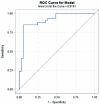Left Atrial Size and Heart Failure Hospitalization in Patients with Diastolic Dysfunction and Preserved Ejection Fraction
- PMID: 28465981
- PMCID: PMC5353466
- DOI: 10.4103/2211-4122.199064
Left Atrial Size and Heart Failure Hospitalization in Patients with Diastolic Dysfunction and Preserved Ejection Fraction
Abstract
Context: Heart failure with preserved ejection fraction (HFpEF) is a clinical syndrome associated with diastolic function abnormalities. It remains unclear which factors, if any, can predict the transition from asymptomatic diastolic dysfunction to an overt symptomatic phase.
Materials and methods: Patients hospitalized with suspected heart failure between January 2012 and November 2014 with a transthoracic echocardiogram demonstrating preserved systolic function were screened (n = 425). Patients meeting the American College of Cardiology Foundation/American Heart Association definition for HFpEF (n = 40) were matched in a 1:1 fashion to individuals admitted for hypertensive urgency with diastolic dysfunction and neither pulmonary edema nor history of heart failure (n = 40). The clinical records and echocardiograms of all eighty patients included in this retrospective study were reviewed.
Results: Patients with HFpEF had higher body mass index (BMI), creatinine, beta-blocker use, and Grade 2 diastolic dysfunction when compared to the hypertensive control population. Echocardiographic analysis demonstrated higher right ventricular systolic pressures, left ventricular mass index, E/A, and E/e' in patients with HFpEF. Similarly, differences were observed in most left atrial (LA) parameters including larger LA maximum and minimum volume indices, as well as smaller LA-emptying fractions in the heart failure group. Multivariate logistic regression analysis revealed LA minimum volume index (odds ratio [OR]: 1.23 [1.09-1.38], P = 0.001) to have the strongest association with heart failure hospitalization after adjustment for creatinine (OR: 7.09 [1.43-35.07], P = 0.016) and BMI (OR: 1.11 [0.99-1.25], P = 0.074).
Conclusion: LA minimum volume index best correlated with HFpEF in this patient cohort with diastolic dysfunction.
Keywords: Diastolic dysfunction; heart failure with preserved ejection fraction; left atrium.
Conflict of interest statement
There are no conflicts of interest.
Figures
References
-
- Yancy CW, Jessup M, Bozkurt B, Butler J, Casey DE, Jr, Drazner MH, et al. 2013 ACCF/AHA guideline for the management of heart failure: A report of the American College of Cardiology Foundation/American Heart Association Task Force on Practice Guidelines. J Am Coll Cardiol. 2013;62:e147–239. - PubMed
-
- Herbots L, Jin Y, Stolarz-Skrzypek K, Staessen JA. Systolic and diastolic left ventricular dysfunction: From risk factors to overt heart failure. Expert Rev Cardiovasc Ther. 2010;8:251–8. - PubMed
-
- Zile MR, Gottdiener JS, Hetzel SJ, McMurray JJ, Komajda M, McKelvie R, et al. Prevalence and significance of alterations in cardiac structure and function in patients with heart failure and a preserved ejection fraction. Circulation. 2011;124:2491–501. - PubMed
LinkOut - more resources
Full Text Sources
Other Literature Sources


